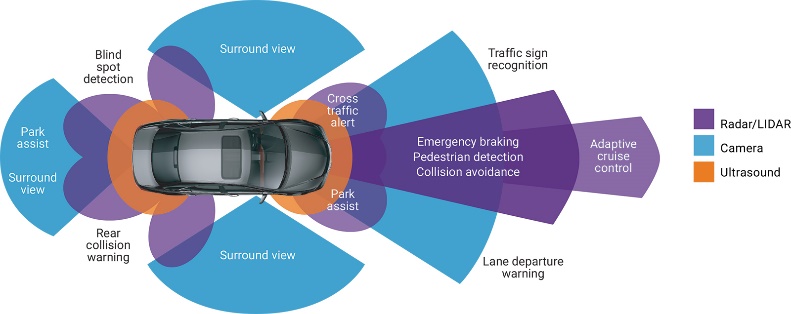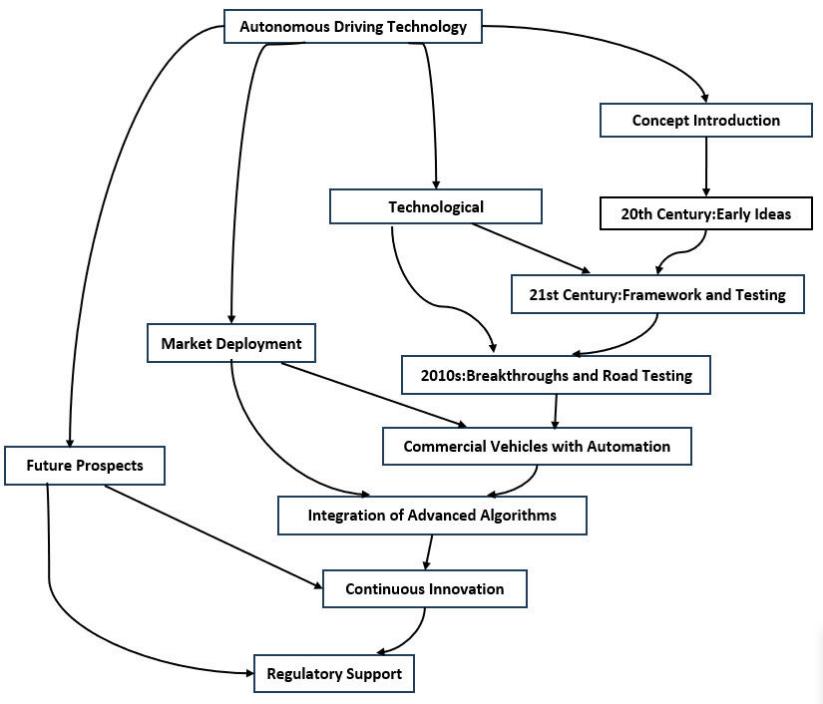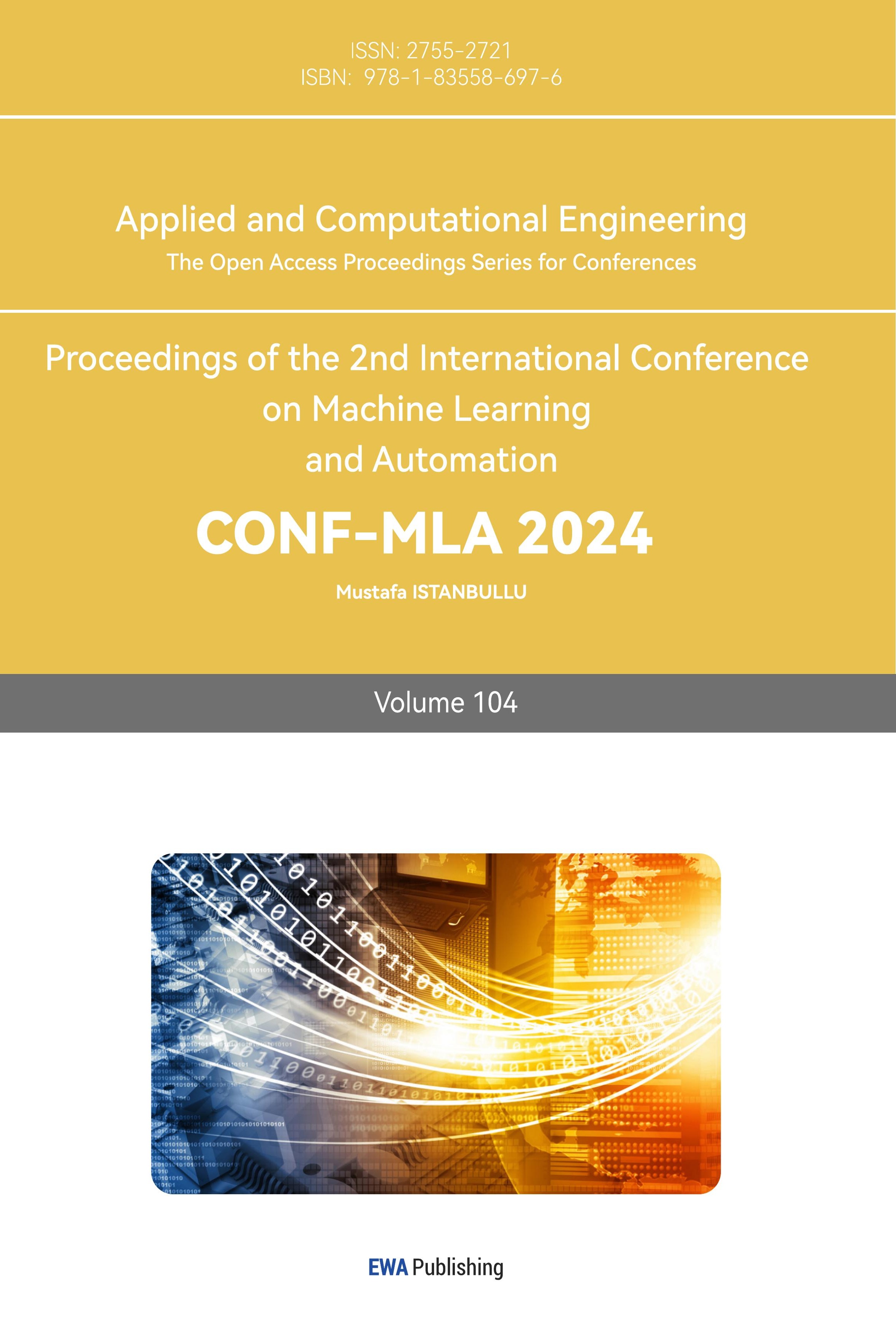1. Introduction
Intelligent interconnectivity is a prominent feature of self-driving cars. With the rise of artificial intelligence and big data, cars are evolving from traditional “machines” into "supercomputer" capable of processing information, communication, and entertainment [1]. The development of smart vehicles has entered a new phase. The core concept of interconnectivity is to enable communication between vehicles through wireless technology. At present, several smart connected cars have already entered the market. This intelligent technology involves equipping cars with sensors, GPS satellite positioning, and high-precision maps, and using advanced algorithms and software to control driving. This can partially or fully free the driver from having to control the car with their hands, feet and eyes, thus enhancing and ensuring driving safety. Interconnectivity refers not only to the exchange of information within the car but also to interactions with the external traffic environment. The intelligent connected cars are characterized by high perception, quick response, autonomous decision-making, self-learning ability, and self-protection [2]. In order to improve traffic safety and efficiency, this study examines the development trends, obstacles, and tactics for autonomous driving technology. It also offers resources for policy optimization and technological innovation.
2. Development trends of autonomous driving
2.1. The history and current status of autonomous driving technology
The early exploration of autonomous driving technology began in the 1980s, marking the germination of research in this field. During this period, many universities and research institutions started investigating the feasibility and basic technology of autonomous vehicles. The Navlab project at Carnegie Mellon University and the VaMoRs project at the Technical University of Munich are two iconic early research projects [3]. The Navlab project focused on developing cars that could drive autonomously in urban environments, while the VaMoRs project was dedicated to researching the autonomous navigation capabilities of vehicles.
Entering the 21st century, with the rapid development of sensor technology, computing power, and artificial intelligence algorithms, autonomous driving technology has achieved significant breakthroughs. Representative companies of this period include Tesla and Google's Waymo [4]. Tesla has integrated advanced autonomous driving functions into its electric vehicles, promoting the commercialization of this technology. Waymo, on the other hand, has demonstrated the potential and reliability of autonomous driving technology by testing its self-driving cars on public roads. The investment and innovation of these companies have not only driven technological development but also set benchmarks for the entire industry. Autonomous driving technology has currently reached levels L3 and L4, allowing vehicles to achieve autonomous driving under specific conditions, such as on certain highways and in urban environments, without the need for human driver intervention [4].
2.2. The future trends of autonomous driving technology
Observing the development direction of current technology, we can see that the progress of autonomous driving technology mainly focuses on several core areas:
First of all, the system fully adopts the technical means of automatic driving. With the improvement of technology, it is expected that in the future, the vast majority of vehicles will reach the standard of automatic driving, which will help reduce the negative impact of human driving and enhance driving safety [5].
The second point is about the cooperative operation between man and machine. In addition, due to the use of mechanical control, the driver can also make corresponding adjustments according to the actual situation, so that he can complete the task more flexibly. After installing sensors and control systems on traditional cars, the operation of vehicles can be controlled by computers, which can reduce the frequency and duration of manual intervention. In the automatic driving system, the driver can make decisions using their own senses without relying on any intelligent equipment, achieving the effect of autonomous driving. Although the current autonomous driving technology still needs human intervention, the idea of cooperative driving between man and machine is still constantly discussed and mentioned.
The third point is about the technology of networked autonomous driving. For example, the use of driverless technology on expressways can reduce the frequency of traffic accidents, reduce the degree of air pollution and improve travel efficiency [6]. With the integration of intelligent transportation systems and traditional transportation modes, people have the ability to realize remote control of cars through the network. Meanwhile, the driverless system can also use advanced sensors and wireless communication equipment to sense the road conditions and transmit these data to the driver in time. With the wider application of 5G vehicle networking technology, the interaction between self-driving vehicles is expected to be significantly enhanced. When vehicles are driving on the road, they will rely on high-speed communication technology to transmit information and process it efficiently, so as to realize a faster and safer common driving experience.
3. Autonomous driving technology
3.1. Technological advancement
The future advancements in autonomous driving technology will increasingly rely on advanced sensor technology, big data processing, and artificial intelligence algorithms. LiDAR technology, which emits and measures reflected laser beams, can accurately map the three-dimensional images of the surrounding environment, playing a key role in enhancing the vehicle's perception capabilities, especially in complex or dynamically changing environments as shown in Figure 1 [7]. Deep learning algorithms, which mimic the structure of human brain neural networks, can process and analyze large amounts of data, thereby improving the decision-making capabilities of autonomous vehicles. They can recognize and predict traffic patterns, pedestrian behavior, and vehicle movements, enhancing driving safety and efficiency. At the same time, as the volume of data collected by vehicle sensors continues to increase, big data processing technology becomes crucial. It enables the autonomous driving system to better understand traffic conditions and make more accurate predictions and decisions through efficient data management and analysis. These technological advancements will collectively push autonomous driving towards higher levels of automation and intelligence.

Figure 1. Sensor System of Autonomous Driving Technology
3.2. Two technical routes to realize automatic driving
The technology of autonomous driving is mainly divided into two independent technical methods. One method includes visual navigation, speech recognition, radar and other technologies. Another method involves autonomous driving, which means using various sensing technologies to identify the surrounding environment and respond according to the collected data. This method uses artificial intelligence to realize intelligent navigation functions. A driver assistance technology known as ADAS (Advanced Driver Assistance Systems) relies on sensors for detection and control [8]. If the driver disobeys traffic rules, the device will issue an alarm or stop the vehicle. This technology acts like an “eye” for the car, allowing it to clearly see traffic signs, surrounding vehicles, and pedestrians. On the basis of observing the traffic rules, the system can also effectively avoid nearby obstacles, thus enabling the autonomous driving function. Another strategy is to use vehicle-to-vehicle communication V2V(Vehicle-to-vehicle), vehicle-to-road communication V2I(Vehicle-to-Infrastructure) and V2X vehicle communication and intelligent transportation technology to equip vehicles with communication technologies [9]. This can ensure that cars can communicate with nearby traffic signs, toll stations, cars, motorcycles, bicycles and pedestrians, so as to realize safe driving while observing traffic laws and making way for pedestrians. This kind of system is usually called a car navigation system. This is an automatic driving system which uses ultrasonic technology to enable navigation and voice prompts, also known as an intelligent transportation assistance system.
3.3. Data support & case sharing
Autonomous vehicles are becoming a focal point in the automotive industry for their exceptional safety and efficiency. Data provided by the International Organization of Motor Vehicle Manufacturers (OICA) shows that autonomous driving technology has a significant effect in reducing traffic accidents, potentially decreasing accidents by about 90%. This statistic demonstrates its potential to enhance road safety. Additionally, autonomous vehicles optimize driving routes and speeds, significantly improving transportation efficiency. Studies indicate that this technology could increase traffic flow by about 15% and reduce traffic congestion by approximately 30%. Furthermore, autonomous driving technology reduces reliance on professional drivers, lowering labor costs, thereby decreasing transportation costs by reducing traffic accidents and improving fuel efficiency. These key statistics and research results collectively demonstrate the significant value and potential of autonomous vehicles in the future transportation system [10].
For example, Waymo's autonomous taxi service launched in Arizona has proven the reliability of autonomous driving technology there, after years of safe operation. This service not only provides passengers with a safe and convenient travel option, but also accumulates valuable data and experience for the further development of autonomous driving technology. At the same time, Tesla's Autopilot system, as one of the earliest commercialized autonomous driving features, has achieved significant results in improving driving safety and convenience through continuous updates and optimizations. Tesla owners can use this system to enable partial autonomous driving functions on highways, effectively reducing driving fatigue and accident risks. These cases vividly demonstrate the potential and positive impact of autonomous driving technology in real-world scenarios.
3.4. Application scenarios
Autonomous driving technology demonstrates tremendous potential for application across various fields, particularly in enhancing road safety. By employing advanced sensors and algorithms, self-driving cars can significantly reduce traffic accidents caused by human error. Moreover, this technology can effectively alleviate traffic congestion by optimizing driving routes and speeds, reducing unnecessary stops and delays. Additionally, autonomous driving technology reduces reliance on professional drivers, and lowers labor costs, while further reducing transportation costs by optimizing routes and improving fuel efficiency. This brings revolutionary changes to the transportation industry.

Figure 2. Development Path of Autonomous Driving Technology.
4. Challenges and limitations
The development of autonomous driving technology is advancing rapidly, promising to revolutionize our modes of transportation, enhance road safety, reduce traffic congestion, and offer drivers more convenience and freedom. However, to realize this vision, we must first address a series of technical challenges. The maturity of the technology is crucial; autonomous driving systems need to continue evolving to ensure high reliability and robustness in various complex and unpredictable traffic environments. This includes improving sensors to more accurately recognize and respond to the surrounding environment, as well as optimizing algorithms to better handle and predict the behavior of other road users. Additionally, autonomous vehicles must be capable of dealing with extreme weather conditions and non-standard traffic situations, such as road construction or the passage of emergency vehicles.
Beyond technical challenges, the promotion of autonomous driving also faces legal and ethical constraints. Regulatory differences across countries and regions may pose obstacles to the global spread of the technology. To address this issue, the international community must work together to establish unified standards and regulations to ensure the safety and compliance of autonomous vehicles worldwide. At the same time, the construction of infrastructure for intelligent transportation systems and vehicle-to-vehicle communication technology is also key. These technologies can provide real-time traffic information, optimize route planning, and facilitate communication between vehicles, thereby improving the efficiency and safety of autonomous driving. Public acceptance of autonomous driving technology is also a factor that cannot be ignored. Many people have reservations about the safety and privacy protection offered by the technology, which requires the industry to gradually build public trust through education, transparent communication, and demonstrating the actual benefits of the technology. Finally, as technology develops, ethical and legal issues related to autonomous driving, including the assignment of responsibility in the event of an accident and the protection of the privacy rights of passengers and pedestrians, need to be resolved. All of these require in-depth discussion and proper resolution before the technology is fully realized.
5. Conclusion
At present, the development and future trend of autonomous driving technology have undoubtedly become a central focus of public interest. As an innovative form of transportation, self-driving cars represent an advanced intelligent transportation system powered by artificial intelligence. These vehicles have the potential to not only enhance traffic efficiency but also reduce the workload of drivers, thus decreasing the incidence of traffic accidents. Self-driving cars are already being used globally. While challenges such as boundary recognition and safety concerns remain unresolved, ongoing research and innovation across various fields are expected to lead to continuous improvements in autonomous driving technology. This progress will significantly boost the safety, efficiency, and convenience of transportation, ushering in a new era for the travel industry.
Acknowledgment
I would like to thank the professor for his knowledge and inspiration in the class, as well as his professional advice and help in the research process. Thanks to the teaching assistant's careful explanation and feedback, I was able to better understand the complex content. I am also very grateful to my classmates for discussing and communicating with me, which made my learning process richer and more interesting. Thanks to my parents for their care and support all the time.
References
[1]. Garikapati, D., Shetiya, S. S. 2024. Autonomous Vehicles: Evolution of Artificial Intelligence and the Current Industry Landscape [J]. Big Data and Cognitive Computing, 8(4): 42.
[2]. CognitiveClouds. 2024. IoT in Automotive Industry: IoT-Enabled Smart Cars and Connected Vehicles [J]. CognitiveClouds Blog.
[3]. Eduarda P ,Helena M ,C. I L , et al. 2023. Trends in Motion Sickness Countermeasures for Autonomous Driving: review and future research[J]. Transportation Research Procedia, 723102-3109.
[4]. Ge Z ,Ding P ,Zhai W , et al. 2024. Multifunctional fiber-shaped flexible wearable strain sensor with high sensitivity and wide sensing range for detecting autonomous driving technology in automobiles[J]. Composites Communications, 48101909-.
[5]. Shladover, S. E., Nowakowski, C., Chan, C. Y. 2021. Automated Vehicle Technology: Liability, Insurance, and Ownership [R]. California PATH Research Report, UCB-ITS-PRR-2021-05.
[6]. University of Cambridge. 2019. Driverless cars working together can speed up traffic by 35 percent [J]. ScienceDaily.
[7]. Miklós L, Szabolcs P, Zoltán M, et al. 2023. Combining survey-based and neuroscience measurements in customer acceptance of self-driving technology[J]. Transportation Research Part F: Psychology and Behaviour, 9546-58.
[8]. Micron Technology Inc. 2021. C-V2X: A sixth sense for ADAS and autonomous vehicles [J]. Micron Blog.
[9]. Verizon Connect. 2021. What Is V2V Technology?: V2V vs V2I vs V2X Technology Systems [J]. Verizon Connect.
[10]. Milakis, D., Van Arem, B., Van Wee, B. 2017. Policy and society related implications of automated driving: A review of literature and directions for future research [J]. Journal of Intelligent Transportation Systems, 21(4): 324-348.
Cite this article
Wang,X. (2024). An Analysis of the Future Trends and Challenges of Autonomous Driving Technology. Applied and Computational Engineering,104,47-52.
Data availability
The datasets used and/or analyzed during the current study will be available from the authors upon reasonable request.
Disclaimer/Publisher's Note
The statements, opinions and data contained in all publications are solely those of the individual author(s) and contributor(s) and not of EWA Publishing and/or the editor(s). EWA Publishing and/or the editor(s) disclaim responsibility for any injury to people or property resulting from any ideas, methods, instructions or products referred to in the content.
About volume
Volume title: Proceedings of the 2nd International Conference on Machine Learning and Automation
© 2024 by the author(s). Licensee EWA Publishing, Oxford, UK. This article is an open access article distributed under the terms and
conditions of the Creative Commons Attribution (CC BY) license. Authors who
publish this series agree to the following terms:
1. Authors retain copyright and grant the series right of first publication with the work simultaneously licensed under a Creative Commons
Attribution License that allows others to share the work with an acknowledgment of the work's authorship and initial publication in this
series.
2. Authors are able to enter into separate, additional contractual arrangements for the non-exclusive distribution of the series's published
version of the work (e.g., post it to an institutional repository or publish it in a book), with an acknowledgment of its initial
publication in this series.
3. Authors are permitted and encouraged to post their work online (e.g., in institutional repositories or on their website) prior to and
during the submission process, as it can lead to productive exchanges, as well as earlier and greater citation of published work (See
Open access policy for details).
References
[1]. Garikapati, D., Shetiya, S. S. 2024. Autonomous Vehicles: Evolution of Artificial Intelligence and the Current Industry Landscape [J]. Big Data and Cognitive Computing, 8(4): 42.
[2]. CognitiveClouds. 2024. IoT in Automotive Industry: IoT-Enabled Smart Cars and Connected Vehicles [J]. CognitiveClouds Blog.
[3]. Eduarda P ,Helena M ,C. I L , et al. 2023. Trends in Motion Sickness Countermeasures for Autonomous Driving: review and future research[J]. Transportation Research Procedia, 723102-3109.
[4]. Ge Z ,Ding P ,Zhai W , et al. 2024. Multifunctional fiber-shaped flexible wearable strain sensor with high sensitivity and wide sensing range for detecting autonomous driving technology in automobiles[J]. Composites Communications, 48101909-.
[5]. Shladover, S. E., Nowakowski, C., Chan, C. Y. 2021. Automated Vehicle Technology: Liability, Insurance, and Ownership [R]. California PATH Research Report, UCB-ITS-PRR-2021-05.
[6]. University of Cambridge. 2019. Driverless cars working together can speed up traffic by 35 percent [J]. ScienceDaily.
[7]. Miklós L, Szabolcs P, Zoltán M, et al. 2023. Combining survey-based and neuroscience measurements in customer acceptance of self-driving technology[J]. Transportation Research Part F: Psychology and Behaviour, 9546-58.
[8]. Micron Technology Inc. 2021. C-V2X: A sixth sense for ADAS and autonomous vehicles [J]. Micron Blog.
[9]. Verizon Connect. 2021. What Is V2V Technology?: V2V vs V2I vs V2X Technology Systems [J]. Verizon Connect.
[10]. Milakis, D., Van Arem, B., Van Wee, B. 2017. Policy and society related implications of automated driving: A review of literature and directions for future research [J]. Journal of Intelligent Transportation Systems, 21(4): 324-348.









